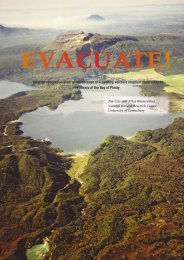Volcanoes - Ministry of Civil Defence and Emergency Management
Volcanoes - Ministry of Civil Defence and Emergency Management
Volcanoes - Ministry of Civil Defence and Emergency Management
Create successful ePaper yourself
Turn your PDF publications into a flip-book with our unique Google optimized e-Paper software.
Location Population If Only 60% Evacuate<br />
Rotorua District 64,473 ~ 39,000<br />
Kawerau District 6,975 ~ 4,000<br />
Te Teko 630 ~ 400<br />
Te Puke 6,774 ~ 4,000<br />
Murupara 1,959 ~ 1,200<br />
Whakatane District 32,814 ~ 20,000<br />
Tauranga District 90,906 ~ 55,000<br />
Total 204,531 ~125,000<br />
Table 3. Populations <strong>and</strong> possible numbers <strong>of</strong> evacuees in the Bay<br />
<strong>of</strong> Plenty region (Census, 2001)<br />
well before any evacuation is necessary. Plans for<br />
hospitals, schools <strong>and</strong> nursing homes should already<br />
have been implemented by each authority, but<br />
individual facilities <strong>and</strong> institutions also need to have<br />
an evacuation plan. To achieve this, communication<br />
links must be established early in the pre-eruption stage.<br />
Locations <strong>of</strong> evacuation shelters should be confirmed<br />
<strong>and</strong> made accessible <strong>and</strong> known to agencies <strong>and</strong> the<br />
public. Vehicle protection, ash clearance, bulk ash<br />
disposal, contractor resources <strong>and</strong> arrangements, <strong>and</strong><br />
availability <strong>of</strong> fuel are also important. Lists <strong>of</strong> special<br />
equipment <strong>and</strong> supplies should be compiled, including<br />
tow trucks, <strong>and</strong> taxi/private bus companies. Plans<br />
for potential receiving cities need to be updated; the<br />
availability <strong>of</strong> fuel <strong>and</strong> suitable accommodation will<br />
need to be monitored prior to an event.<br />
EVACUATION ROUTE INFORMATION:<br />
The evacuation movement can be either preeruption<br />
or during-eruption. The primary method <strong>of</strong><br />
evacuation movement in this area has to be by road,<br />
although there is a rail link to Kawerau. Before the<br />
eruption, road conditions are unaffected by ash, but<br />
apprehension may affect driving skills. Evacuation<br />
movement during periods <strong>of</strong> ashfall, is drastically<br />
changed by road conditions, <strong>and</strong> therefore, the<br />
subsequent action taken by drivers. Under this scenario,<br />
most recommended <strong>and</strong> compulsory evacuations take<br />
place before any substantial ashfalls in the area.<br />
Viable destinations for evacuees from Rotorua<br />
include Hamilton, Auckl<strong>and</strong> <strong>and</strong> possibly Tauranga <strong>and</strong><br />
Taupo. However, evacuation to Tauranga <strong>and</strong> Taupo,<br />
or to any other city within the Bay <strong>of</strong> Plenty region,<br />
is better only as an interim measure. These centres<br />
could need to be evacuated themselves if the eruption<br />
escalated or wind direction changed. If the route to<br />
Taupo is taken, the recommendation given to evacuees<br />
will be to travel south along SH 30 through to SH 1,<br />
as SH 5 passes close to the Primary Evacuation Zone<br />
<strong>and</strong> may be closed prior to the eruption. If the route<br />
to Hamilton is taken, the recommendation given to<br />
evacuees will be to travel via SH 5 to SH 1 (Fig 4).<br />
Clear advice needs to be given to the public,<br />
recommending evacuation routes <strong>and</strong> destinations (or<br />
destinations to avoid), well in advance <strong>of</strong> an evacuation<br />
warning.<br />
If the population leaves Kawerau via Kawerau<br />
Road to SH 30, the choice lies in either going to the west<br />
or east (along SH 30). The best option is to take SH 30 to<br />
the east (Fig 5); they could then travel to Te Teko, turn<br />
south <strong>and</strong> follow the south route <strong>and</strong> travel on to Taupo<br />
via Murupara; or could turn north from Te Teko, or to<br />
Matata, on the coast, <strong>and</strong> then northwest to Tauranga.<br />
Following this route would be slow, <strong>and</strong> would involve<br />
travelling in ashfall-prone areas, once the eruption<br />
has commenced. Going to the west will compound the<br />
problems in the Rotorua area.<br />
A second option is to leave Kawerau by the<br />
southern forestry road to Ngamotu Road, although<br />
this comes in close proximity to Tarawera volcano, just<br />
outside <strong>of</strong> the Primary risk zone. This option is only<br />
possible pre-eruption, <strong>and</strong> is likely to be closed as soon<br />
as the eruption begins. The options from here are east to<br />
Pokairoa Road, following it south to Kopuriki Road until<br />
Murupara, then turn west earlier to Rainbow Mountain<br />
<strong>and</strong> south to Taupo.<br />
EVACUATION BY ROAD<br />
This is likely to be the most common<br />
transportation method used in evacuations for the<br />
Rotorua-Kawerau districts. Most people will be advised<br />
to evacuate by car, except for a few minority groups<br />
who will neither be able to drive, nor be able to<br />
travel with friends <strong>and</strong> family. These include special<br />
population groups such as hospital patients, residential<br />
District<br />
Cars<br />
Rental<br />
cars<br />
Taxis<br />
Trucks<br />
Buses &<br />
coaches<br />
Trailers<br />
Motorcycles<br />
Mopeds<br />
Tractors<br />
Exempt<br />
vehicles<br />
Misc.<br />
Total<br />
Auckl<strong>and</strong> 625,590 11,329 3,497 94,595 3,088 71,746 9,187 828 2,530 1,325 3,972 827,687<br />
Hamilton 145,457 481 267 33,112 1,135 38,091 3,200 828 2,486 578 1,190 226,825<br />
Tauranga 92,357 321 129 20,395 506 22,715 2,340 610 1,184 546 1,159 142,262<br />
Rotorua 32,311 69 99 8,147 260 8,284 653 117 459 332 333 51,064<br />
Table 4. Vehicle numbers (registered) in the Bay <strong>of</strong> Plenty/Waikato/Auckl<strong>and</strong> regions (From L<strong>and</strong> Transport Safety Authority, 2000)<br />
50<br />
TEPHRA<br />
June 2004

















